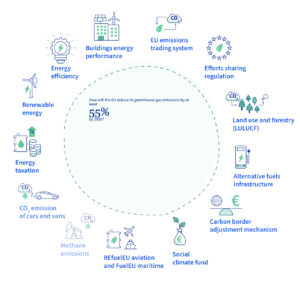In late October, European Union (EU) lawmakers agreed to ban the sale of new combustion engine vehicles by 2035 in an effort to speed up the transition to electric vehicles.
For months, member states went back and forth with whether to support or oppose the latest ban. At the same time, many carmakers in the EU had already committed to an electric vehicle (EV) transition before the ban.
As states now prioritize the transition, some are experiencing major pitfalls from a costly economy while others are making relative progress.
What does the ban entail?
Under the new ban, carmakers are required to reduce the emissions of new cars by 55% in 2030 — with the final deadline of a 100% cut set in 2035.
The EU Parliament will allocate funding to assist small- and medium-sized businesses in the automotive industry.
The ban was ultimately part of the “Fit for 55” package aimed at reducing the EU’s greenhouse gas emissions.

Through “Fit for 55,” the EU plans to reduce emissions by 55% in 2030 by implementing energy taxes, transitioning to renewable energy, and increasing energy efficiency, among numerous other methods.
One of the biggest tasks for “Fit for 55” is to reduce CO2 emissions from vehicles; the ban is now making this dream goal a push for reality.
Part of the reason the EU has chosen to focus on the transition to electric vehicles is the amount of EU emissions that is dominated by the automotive industry.
According to EU data, transportation is the only sector that has increased emissions in the past three decades, rising 33.5% between 1990 and 2019. Passenger cars specifically are a big polluter, accounting for 61% of total CO2 road emissions.
As member states now work to reduce these CO2 emissions, many are facing both ups and downs.
Germany
Germany, home of major automobile brands such as Mercedes-Benz, Volkswagen, Audi, Porsche and BMW, is one of the most important European countries when it comes to the transition to EV’s, if not the most important.
Prior to the EU’s ban, Germany had already been making its way toward EV’s. At the end of 2021, Chancellor Olaf Scholz from the Social Democratic Party of Germany, took office with a heavy focus on the green transition.
Soon after, the German government set an ambitious target of having 15 million EVs on its roads by 2030, with only one million at the time, and pledged to have 80% of electricity coming from renewable sources.
Already, 26% of the cars coming out of Germany are either fully or partially electric. However, these numbers do not exclude them from the financial hardships of EV’s.
Some, such as Ferdinand Dudenhöffer, a professor at the Center for Automotive Research in Duisburg, warn that the target is too ambitious and that the pressure on car makers could ultimately make the market crash.
“The federal government’s target for 15 million electric cars on Germany’s roads by 2030 will be missed by a wide margin,” said Dudenhöffer. “With the new funding guideline for electric cars, high electricity prices and rising battery costs, the market in Germany will collapse in the next few years.”
With high inflation, a shortage in supply chains, and rising competition, the EV transition on a global scale faces a rocky road — one where few electric vehicles may be able to drive on.
Already, Germany is experiencing problems because of the ban due to their generous subsidies program.
A previous round of German subsidies were offered to German automakers, however, because German cars are sold on both a continental and even global scale, these subsidies are benefiting EV purchases made by other countries with less generous programs. Basically, Germany is pouring money into their EV transition, while others are benefiting — German EV’s making not nearly the impact they should in Germany.
At the moment, the German government is looking to close this loophole by forcing auto consumers to hold onto their vehicles for a year before they can be eligible for more subsidies.
However, this doesn’t mean the German market isn’t making progress: in the first nine months of the year, Germany had sold 273,101 battery-electric vehicles, 15% more than in the same period in 2021.
For Germany, a transition is already happening, just one with potholes and bumps in the road.
France
Heading into negotiations, France was in support of the ban as long as it allowed for PHEVs (hybrid vehicles) until 2040.
Yet, when the ban was finalized, France decided to fully commit alongside member states to go fully electric by 2035.
The commitment, though, has paved the way for many new challenges for France, both “social and economic.”
For one thing, moving away from combustion engines means French workers need to be retrained to produce electric vehicles in a sector that at first, specifically in June of 2022, called the EU ban on combustion engines “industrial destruction.”
Luc Chatel, president of the French car manufacturing trade union PFA, argues that a number of elements of the EV sector are not ready for the big transition. One of them, he notes, is the lack of EV charging stations and how far apart they remain. Chatel notes France would need to have one million charging stations by 2030 — 940,000 more that it currently has.
Additionally, he states the high cost of electric cars compared to combustion cars poses problems.
“I don’t think we will have the clients for electric cars; bear in mind they are twice as expensive as combustion cars,” said Chatel.
In an effort to make EV’s more affordable and accessible, France created the “socal leasing idea” — which will allow the most vulnerable people to acquire an EV for 100 euros a month.
Others have argued a transition to EV’s will open up more job opportunities in the automobile sector, despite the difficulties of retraining current employees.
Italy
Initially, former Prime Minister of Italy Mario Draghi fully supported the “Fit for 55” package, committing to phase combustion engines by 2035 in December of 2021. Yet mounting pressure consumed Draghi, putting the transition on hold.
At the moment, Italy’s EV and traditional motor market shares are falling behind compared to other member nations. Not only is Italy losing out to big automaker competitors like Germany and France, but also to counties such as Bulgaria and Romania.
In other words, with only 3.7% of new cars being electric, Italy is transitioning, but relatively slowly.
Part of the reason the transition is happening at a snail’s pace is the continued disagreements taking place between ministers.
Transport and labor ministers are in agreement with the transition, however, industry ministers are seeking to reopen discussions over supporting the “Fit for 55.” Many industry ministers claim the transition will lead to a “bloodbath” for jobs.
Yet many automakers in Italy have rejected these claims from industry ministers, one of them being Fiat, a major car manufacturer.
“Despite a general resistance from the public driven by the false narrative on job losses, civil society, in particular the unions, got behind the phase-out. They realized that postponing the 2035 phase-out would not save jobs; it would do the opposite,” said Carlo Tritto, representative of T&E Italy, the Italian office of Transport and Environment.
The current transport minister, Matteo Salvini, is trying to re-encourage support for the transition — and he is already making progress.
After the Automotive Table, an industry-government working group conference, the industry minister called for an EU industry-wide response to the US and China’s latest support for their own automotive industries.
France and Germany have quickly jumped on the EU EV train afterward and have already made progress, while Italy is just starting to take its first baby steps.
Despite lagging behind other major European economies, Italy is stepping in the right direction.
Spain
Spain is Europe’s second biggest car manufacturer and therefore another important member state when it comes to the “Fit for 55” package.
From the beginning, Spain’s left-wing coalition led by Pedro Sánchez had been in favor of the combustion engine phase-out.
Initially, Spain wanted to shoot even higher than other EU member nations by setting a new target in 2027 and an even higher target than 55% in 2030. However, opposing outlooks between parties have led these targets to be abandoned — yet, Spain is still in full support of the revised 2030 and 2035 deadlines set by the EU.
Despite high support, Spain has a long way to progress compared to others as it is four times slower in the electric vehicle sector compared to their Portugal neighbors.
At the moment, Spain has 200,000 electric vehicles on the road, and has a target of 5 million by 2030. The government is now aiming to have 100,000 on the road by 2023, yet only 15,000 are up in running today. The country needs to either dramatically increase production or adjust their aims to more realistic targets.
Along with ramping up production, prices will need to come down if Spain expects consumers to invest in electric vehicles over combustion engine vehicles.
As more and more EU countries advance their EV goals, it seems clear that many of them face the same challenges: increasing production quickly enough, combating inflation, and lowering prices among other issues.
Although the EU leads the renewable energy transition and arguably the switch to electric vehicles as well, the ban is still an ambitious target for the 27-member-nation bloc that quite possibly might not be accomplished if individual countries don’t manage to figure out how to ramp up production and achieve net zero emissions by 2050 while still being competitive on the market.
The targets may look slightly grim right now, yet even the mere promise of targets being accomplished at some point down the road is a win for the EU and the environment, particularly as the rest of the world struggles to do the same.
Perhaps more should follow in the EU’s footsteps.
Editor’s Note: The opinions expressed here by the authors are their own, not those of Impakter.com — In the Featured Photo: Electric car on April 8, 2021. Source: Michael Fousert, Unsplash.










